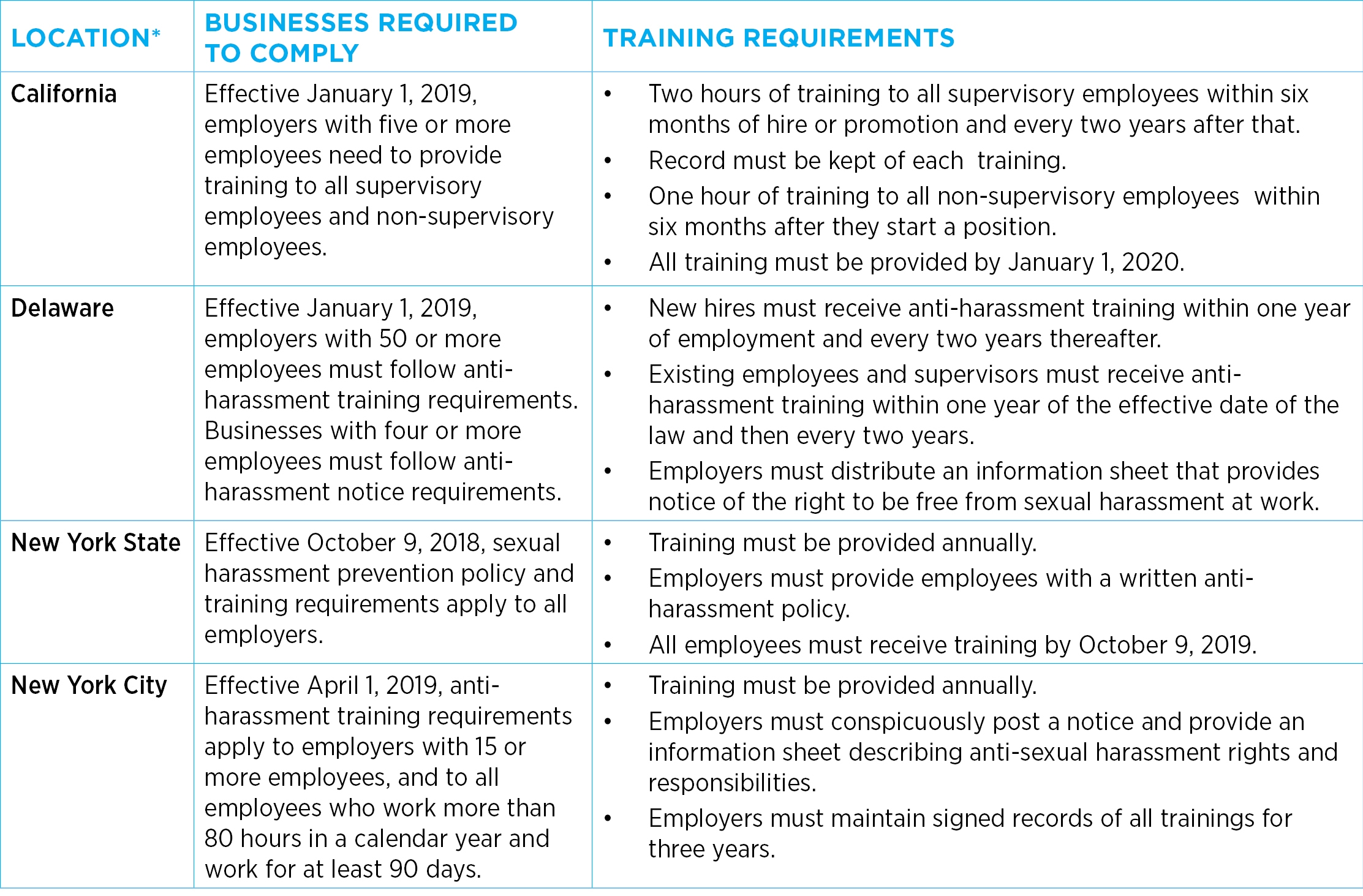Six HR Topics That Businesses Should Keep Top of Mind for 2019

Table of contents
- 1.Harassment prevention
- 2.Gender identity
- 3.Parental leave
- 4.Creative methods of attracting and retaining talent
- 5.Big data
- 6.Mobile and flexible workforce
The landscape for small and medium size businesses is constantly evolving. Every year brings new HR requirements for business owners to navigate. Below are HR topics and trends that are likely to be top priorities for businesses in 2019, as well as some tips to help employers prepare for the year ahead.
1. Harassment prevention
In the next year and beyond, we anticipate that a number of states and cities will pass new legislation or expand on existing anti-harassment legislation that businesses will need to be aware of. The following locations have introduced new and/or updated sexual harassment prevention training requirements for late 2018/2019. Businesses in the following locations should plan to align their anti-harassment policies and training with all applicable regulations. Additionally, businesses operating in cities and states not on this list should still be prepared as anti-harassment legislation may already exist or could be adopted in the months and years ahead.
Additionally, it’s important to note that individual locations have content requirements that companies must include in their training. An HR professional can help businesses plan an anti-harassment training program that meets all applicable content requirements.

*Sources:
California
Delaware
New York State
New York City
For the coming year, training around harassment prevention will likely evolve to encompass the following areas:
- A focus on bystander training, including how to train witnesses, managers and colleagues to recognize, report and, as appropriate, prevent incidents of harassment in the workplace.
- Electronic harassment, such as online harassment, including via social media, as well as harassment via email, instant message and texting. These communication avenues tend to have an informal feel that can make them ripe for conveying harassing conduct.
- The role of gender identity in harassment prevention and training. More on this topic is below.
Employers should make sure their business follows all applicable anti-harassment regulations and best practices to create a work environment where all employees feel safe and supported. This will help businesses remain compliant while fostering a positive workplace culture. An HR professional or professional employer organization can be instrumental in helping design and implement an effective anti-harassment training program.
2. Gender identity
Another big subject over the last couple years that is anticipated to continue in 2019 is how gender identity is managed in the workplace. While the topic of identity in the workplace isn’t new, the conversation has transcended bathroom access to encompass all the ways an accepting workplace that respects employees’ diversity can contribute to a successful business.
Businesses looking to grow may want to consider the following opportunities to attract and retain top talent of all genders:
- Compliance with Equal Employment Opportunity Commission (EEOC) guidelines: The EEOC provides guidelines, applicable to all U.S. employers, that forbid any employment discrimination based on gender identity or sexual orientation. It is important for businesses to make sure their policies and procedures protect employees from discrimination and employers from falling out of compliance with anti-discrimination regulations.
- Anti-discrimination training: We’ve already discussed how anti-harassment policies and training are rapidly becoming requirements in more and more states and cities. As best practices, this should include training on policies that prohibit harassment based on gender identity, gender expression and sexual orientation. In fact, this is already law in California and we can expect to see similar anti-harassment laws in other states and jurisdictions.
- Freedom of gender expression: While there are many instances where an employee’s legal name and sex must be used, such as in IRS documents or for insurance benefits, respecting an employee’s wishes in what name they want to be called, which pronouns they prefer and how they express their identity on a day-to-day basis can help create a workplace culture where all employees are respected. This is something to think about when creating workplace policies such as dress codes. For instance, while your company may need to require business attire be worn in the workplace, best practices would be to still allow employees to dress according to the gender with which they identify. This means not insisting women wear skirts and heels while men are allowed to wear slacks and loafers.
3. Parental leave
There has been a lot of focus in the last couple years on parental leave, with many states, cities and other jurisdictions passing laws to give new parents longer and sometimes even paid time off to bond with their new child. Even in areas where parental leave isn’t the law, many businesses are finding that offering this benefit can be very helpful in competing with other companies for employees who may be planning to become parents. We anticipate the conversation around parental leave to continue in 2019, making it important for businesses that are looking to start offering parental leave or that operate in an area where parental leave is either already a requirement or will soon become one to seek guidance on this issue.
4. Creative methods of attracting and retaining talent
It’s no secret to most employers that the U.S economy is experiencing record low unemployment. Employers are in overdrive right now, looking high and low for the best talent to help them succeed. Businesses competing for a dwindling pool of qualified talent are often turning to creative offerings to help them stand out from the crowd and give prospective employees more of what they want. And what they want, according to a TriNet survey on non-traditional benefits, are the type of perks that contribute to a work-life balance, such as flexible work schedules and remote work options. This is, of course, in addition to traditional employee benefits like health insurance and retirement options.
As we head into 2019, expect to see some unique benefits offerings coming from resourceful employers—think student loan payoffs, vacation stipends and even help buying first homes.
5. Big data
Big data is a big topic in all aspects of business strategy and HR is no exception. In 2019, businesses will be looking to redefine their approach to HR in response to the tight labor market. Workforce analytics will likely become an increasingly important tool to help businesses harness the power of big data to gain actionable insights into their HR, stay on top of what is working within their organization and make informed, strategic decisions to help drive their business forward.
6. Mobile and flexible workforce
As discussed above, employees want flexibility in their work life. Flexibility allows modern employees to better balance the needs of their personal lives with their workplace responsibilities. In 2019, we’ll see real-time HR technology play an increasing role in helping to meet employees’ demands for more work-life integration. Mobile HR applications that help businesses and workers alike manage HR tasks on the go will be a vital part of this trend.

This communication is for informational purposes only; it is not legal, tax or accounting advice; and is not an offer to sell, buy or procure insurance.
This post may contain hyperlinks to websites operated by parties other than TriNet. Such hyperlinks are provided for reference only. TriNet does not control such websites and is not responsible for their content. Inclusion of such hyperlinks on TriNet.com does not necessarily imply any endorsement of the material on such websites or association with their operators.
Table of contents
- 1.Harassment prevention
- 2.Gender identity
- 3.Parental leave
- 4.Creative methods of attracting and retaining talent
- 5.Big data
- 6.Mobile and flexible workforce

